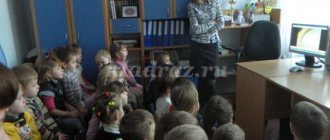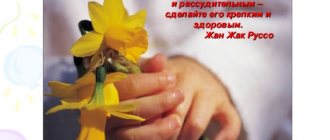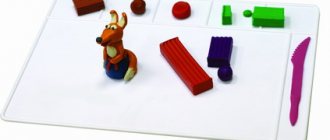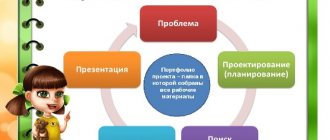Project at a preschool educational institution - what is it? Types of projects used in kindergarten.
Municipal budgetary preschool educational institution "Kindergarten for supervision and health improvement No. 108" in Saratov
Project at a preschool educational institution - what is it? Types of projects used in kindergarten.
Prepared by the teacher
I qualification category
Senina Yulia Viktorovna
2017
What is project work in kindergarten?
Back at the beginning of the twentieth century. Professor Collings, the organizer of a long-term experiment in one of the rural schools in Missouri, proposed the following classification of educational projects:
“game” - children’s activities, participation in group activities (games, folk dances, dramatizations, various types of entertainment);
“excursion” aimed at studying problems related to the surrounding nature and social life;
“narrative”, during the development of which children learn to convey their impressions and feelings verbally and in writing. Vocal (song), artistic (painting), musical (playing the piano) forms;
“constructive”, aimed at creating a specific useful product: putting together a birdhouse, a prepared children's breakfast, arranging flower beds.
By the end of the twentieth century. New types of projects have been developed. E. Polat (1999) characterizes projects in accordance with their typological characteristics: number of participants, dominant method, nature of contacts, method of coordination, duration.
Focusing on these signs, the author offers his own version of the typology of projects relevant for preschool education.
1. According to the dominant method: research, creative, informational, gaming, adventure, practice-oriented.
2. By the nature of the content: include the child and his family, the child and nature, the child and the man-made world; child, society and its cultural values.
3. According to the nature of the child’s participation in the project: customer, expert, performer, participant from the inception of the idea to the receipt of the result.
4. By the nature of contacts: carried out within one age group, in contact with another age group, within a preschool educational institution. In contact with family, cultural institutions, public organizations (open project).
5. By the number of participants: individual, pair, group and frontal.
6. By duration: short-term, medium-term (medium-term) and long-term).
The project sounds somehow official and scientific, doesn’t it? But in fact, this word hides the name of one of the methods for implementing tasks for the development and training of preschoolers. Project activity consists of the joint work of the teacher, parents and children to study a certain issue.
The purpose and purpose of the projects is to promote the development of independent thinking in children, the ability to make decisions, look for answers, plan, foresee the result and learn to cooperate with other people. The teacher gives some task to the children, feasible for their age, and teaches how to solve it and how to present the result of the solution.
Preschoolers cannot develop a project on their own; in kindergarten we do everything together. Typically, this type of activity is purely educational in nature; we use the project as a tool for learning, gaining knowledge and enriching life experience. This method has only recently begun to be used in preschool education; it is considered progressive and effective for modern children.
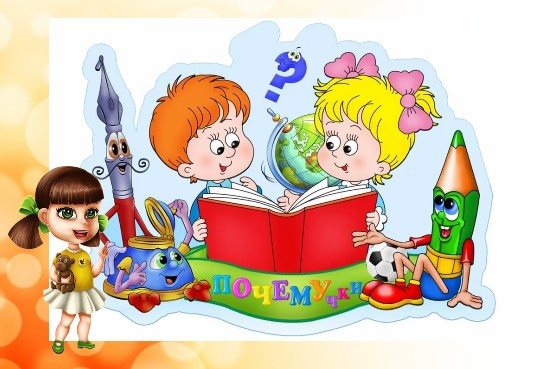
Development and learning in preschool format is carried out mainly through play activities, so projects have a creative, playful orientation. The most effective is group research activities of children.
The topics of the projects are very diverse.
Well, for example, the popular theme for children's projects is “Family Tree” or “My Family”. This project can be implemented in different ways - in the form of a collective panel with photographs of the family of each child in the group, or a painted large tree, or an exhibition of children's works on the theme of the children's family.
The point is not to give children a finished project, but to give them a topic and help them determine the path for implementing the project: what materials to use, who to ask for help, how to design the project product, how to present it. Moreover, this applies not only to children of the senior and preparatory groups. Kids also do projects that they can handle.
For those who want to create a project according to all the rules
The peculiarities of the pedagogical and educational system in Russia are such that every step we take must be strictly in accordance with the Federal State Educational Standard. Therefore, even such a creative task as writing a project requires compliance with the methodological recommendations of the Ministry.
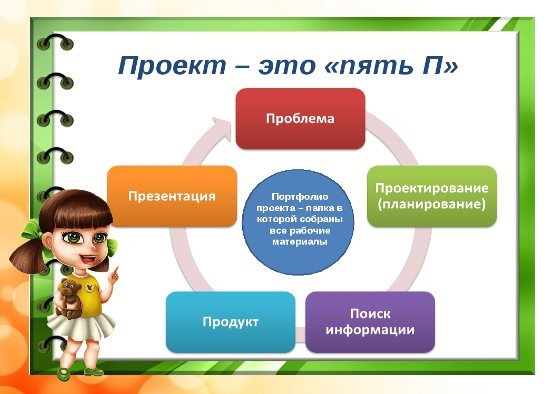
In order not to search for information for a long time, I suggest looking at the UchMag online store, since there is absolutely any methodological literature, including excellent manuals on our topic:
- “Projects in preschool educational institutions: practice of teaching children 3-7 years old”;
- “Innovative pedagogical technologies. Project method in preschool educational institutions";
- “Projects in preschool educational institutions: theory and practice of child development”;
- “Projects in preschool educational institutions. Practice of teaching children 3-7 years old. Program for installation via the Internet";
- “Preschool educational institution development program. CD for computer: innovative educational project";
- “Environmental projects in preschool educational institutions. Research activities on walks."
For preschool teachers, taking into account modern requirements for a preschool teacher, in such manuals you can find everything that is necessary for competent planning and implementation of teaching activities: how to draw up a project, what to take into account, how to formalize the results, etc.
Types of projects in kindergarten
In current practice, kindergartens use the following types of projects:
- Research with a creative bent: the guys find out some information, for example, why snow melts in the spring, and the results are presented in the form of drawings, wall newspapers, staged skits, etc.;
- Creative tasks are also educational in nature, but the results of the research are presented in the form of a theatrical performance, a performance, or a children's party;
- Social and informational: the guys research the subject of the project and draw up the result in the form of a newspaper, folder, poster, installation;
- Role-playing or gaming: children solve a project task using a fairy tale familiar to them, getting used to the roles of the characters, presenting the result of the research in the form of a role-playing plot.
According to the method of project implementation, group, individual, intergroup, complex
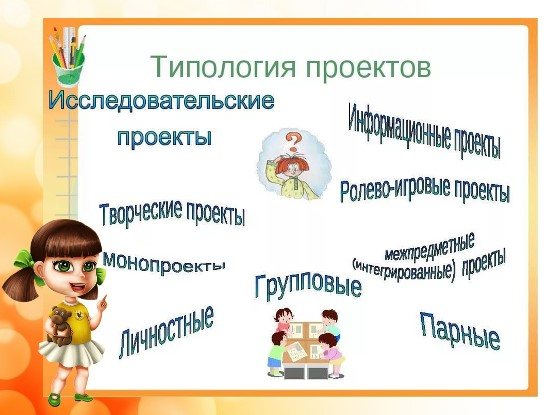
Taking into account the age-related psychological characteristics of preschoolers, project coordination should be flexible, i.e. The teacher unobtrusively guides the children’s work, organizing individual stages of the project.
All projects are carried out within the preschool educational institution, as a rule, between groups of participants, but there are also personal, individual projects (in visual and verbal creativity). Since the leading activity of a preschooler is play, role-playing and creative projects are used from a young age: “Favorite Toys”, “The ABC of Health”, etc.
Other types of projects are also significant, including:
- complex: “World of Theater”, “Hello, Pushkin!”, “Echo of Centuries”, “Book Week”, etc.;
- intergroup: “Mathematical collages”, “World of animals and birds”, “Seasons”, etc.;
- creative: “My friends”, “In our Neskuchny Garden”,
“Favorite Tales”, “Natural World”, “Rowan Bins of Russia”, etc.;
- group: “Tales of Love”, “Know Yourself”, “Yugan Gems”, “Underwater World”, “Fun Astronomy”, etc.;
- individual: “Me and my family”, “Family tree”, “Secrets of grandma’s chest”, “Fairytale bird”, etc.;
- research: “The World of Water”, “Breath and Health”, “Nutrition and Health”, etc.
These projects may seem like they're too difficult for preschoolers. But preschoolers are just getting acquainted with this type of activity, preparing for independent research that they will conduct at school.
Research projects
According to E. Polat, they require a clear structure, defined goals, relevance of the subject of research for all participants, social significance, and thoughtful methods for processing the result. In recent years, research projects have been actively conquering the space of secondary schools and additional education institutions and are increasingly of interest to preschool specialists.
Information projects
Goals: collect information about some object, phenomenon, and then familiarize participants with it, analyze and summarize the observed facts.
Structure of the information project: obtaining and processing information, result (report, album with drawings and photographs), presentation.
Creative projects
They do not have a detailed structure for the joint activities of participants. It is just outlined, and then develops, subordinate to the final result, the interests of the project participants. Teachers and children agree on the form of presenting the results (fairy tale, film, dramatization, holiday, interior decoration). However, the presentation of the results of the project requires a clearly thought-out structure in the form of a film script or a concert program.
Creative projects are varied, as are the types of artistic and productive activities that children master. In content, they reflect the relationship: child - family; child - nature; a child is a man-made world; child – society and its cultural values.
Creative projects can be classified according to the predominant motive (expression of a subjective attitude, bringing joy, providing assistance, joint creativity or activity); by dominant type of creativity (game, visual, constructive, artistic and speech, artistic and design, theatrical, musical); according to the form of presentation of the result (panel, design, performance, decoration, cartoon, concert, holiday, presentation).
Game (adventure) projects
The structure of game projects is just being outlined; participants take on certain roles determined by their character and content. These can be literary characters or fictional characters that simulate social or business relationships in imaginary situations.
The degree of creativity in such projects is high, but the dominant type of activity is still role-playing.
Practice-oriented projects
They are distinguished by a clearly defined expected result of the participants’ activities, oriented towards social interests. A practice-oriented project requires a well-thought-out structure and organization of work at individual stages (adjusting efforts, discussing results and ways to implement them in practice, evaluating the project).
Open Projects
The most common design is within one age group. Teachers and children do not experience difficulties because they know each other’s creative capabilities and social qualities well; have an idea of the subject-spatial environment of the group. However, you should not isolate yourself in your team. Contacts with another age group are necessary for a child for his social development and expansion of the sphere of communication. Participation in a joint project with another group enriches children with new impressions, allows them to experience new emotions, and win sympathy from the people around them. A similar process occurs in a mixed-age group. In such conditions, younger preschoolers have the opportunity to master the world around them with the participation of their elders, and older children gain experience in behavior socially approved by adults.
It is more difficult to organize contacts and projects within preschool educational institutions (for example, “April Fool’s Day”, “Fairy Tale Week”). They require a high level of development of management (creative, organizational) skills among teachers, since it is necessary to identify the current problem, think through the conditions and form of children's or child-adult projects.
The most complex are open projects implemented in contact with family, cultural institutions, and public organizations. But it is they that give a high result in the development of the child, expanding the space of his life.
Individual and collective projects
Individual project - carried out independently, designed to enrich the child’s cultural experience; with its help, the ability to overcome obstacles in solving a problem (composing and illustrating a fairy tale) is monitored. The Value of Custom Design
is undeniable, since the child learns to take initiative, experience mistakes and achievements, and demonstrates abilities.
However, children are collectivists at heart; they want to interact with peers and adults. An essential feature of the psychological characteristics of any person is the ability to participate in collective activities and jointly find ways to solve problems. The formation of stable skills of collective cooperation in preschoolers is facilitated by the constant and purposeful involvement of children in the creation of common works. Children learn to unite in subgroups, discuss together ways to implement a plan, plan and coordinate their actions step by step, distribute responsibilities and tasks among themselves, help each other, worry about the quality of not only their part of the work, but the whole.
The experience of collective creativity is acquired against the background of joint positive emotional experiences that contribute to the development of friendly relationships between children.
Children feel unhappy when they are not in the group. Therefore, pair, group, frontal projects are necessary for children's development.
Pair project
- carried out by a pair (pairs) of participants. Children acquire cooperation skills, learn to act together in the same space, solve a common problem, and choose adequate solutions.
Group project
- carried out by a group of participants (from 3 to 10-12 people).
Frontal (collective) project
- performed by the whole team.
Short term projects
- aimed at solving a small problem or part of a larger one. They can be implemented in one or several specially organized classes, as part of joint activities with adults or independent children's activities (studying the properties of ice; studying the activities of an artist in a workshop).
Medium duration projects
- designed to solve the problem within several days, weeks (preparing for a holiday, travel); writing and staging a fairy tale).
Long-term projects
(from one to several months) - solve a major problem, which requires effort and sufficient time to overcome (for example, researching your ancestry).
Have you probably seen foreign films where children prepare some projects, often making volcanoes, various devices, bringing a pet to kindergarten and talking about it? Such types of activities are extremely useful for children, as they broaden their horizons, activate cognitive activity, and reveal creative and scientific abilities.
The name - projects - sounds very serious to our ears. In fact, for children this is just one type of work that requires research and presentation of the result. Both short-term and long-term projects are designed to increase the child’s self-esteem, since initially the adult is determined to recognize the value of any result of the child’s research.
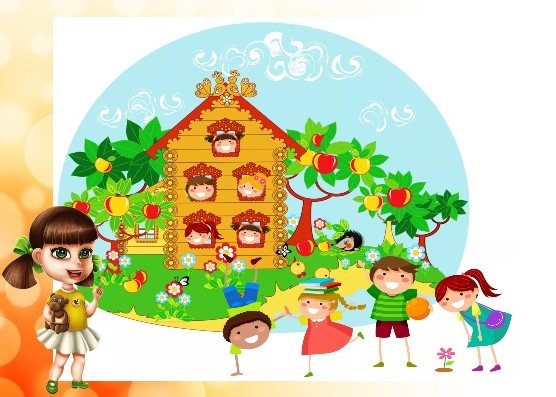
The point is not to get an ideal research result from a child, say, on the topic of a favorite toy. The point is to instill in him an interest in research and analysis of the processes that occur around us. Arousing curiosity and healthy curiosity in children is the task of children's projects.
The tasks of research activities are specific for each age.
In early preschool age this is:
— children’s entry into a problematic play situation (the leading role of the teacher);
— intensifying the desire to look for ways to resolve a problem situation (together with the teacher);
— formation of initial prerequisites for research activities (practical experiments).
In older preschool age this is:
— formation of prerequisites for search activity and intellectual initiative;
- developing the ability to determine possible methods of solving a problem with the help of an adult, and then independently;
— developing the ability to apply these methods to help solve the problem, using various options;
— developing a desire to use special terms, conducting a constructive conversation in the process of joint research activities.
Thus, the project method in working with preschoolers today is an optimal, innovative and promising method that should take its rightful place in the preschool education system. The methodological foundations of project activities discussed above give an idea of the high degree of adaptability of innovative technologies to the specifics of preschool educational institutions.
Using the project method in preschool education as one of the methods of integrated teaching of preschoolers can significantly increase children's independent activity, develop creative thinking, children's ability to independently find information about an object or phenomenon of interest in different ways and use this knowledge to create new objects of reality. It also makes the educational system of preschool educational institutions open to the active participation of parents.
The specificity of using the project method in preschool practice is that adults need to “guide” the child, help discover a problem or even provoke its occurrence, arouse interest in it and “draw” children into a joint project. Based on a person-centered approach to training and education, ultimately, it should contribute to the development of individual creative activity of teachers in the development of strategy, tactics and technology of the educational process, promote the personal development of students, and ensure high-quality results of teaching activities.
The promise of the project method in the preschool educational system is that it provides the opportunity to develop observation and analysis of phenomena, comparison, generalization and the ability to draw conclusions, creative thinking, logic of knowledge, inquisitiveness of mind, joint cognitive-search and research activities, communication and reflective skills and much more that are components of a successful personality.
article "Project method in the activities of a preschool institution"
A.S. Stepanova, teacher
MKDOU Kindergarten "Beryozka" Kharanzhino village
Project method in the activities of a preschool institution.
A child is brought up by various accidents that surround him. Pedagogy must give direction to these contingencies.
V. F. Odoevsky
Reforming preschool education in order to better satisfy the needs of parents and the interests of children places new demands on preschool educational institutions. The introduction of innovations into the work of an educational institution is the most important condition for improving and reforming the preschool education system. Innovation activity is a process that develops in certain stages and allows an institution to move to a higher quality stage of development when creating, developing, mastering, using and disseminating innovations (new methods, techniques, technology, programs).
The development of preschool educational institutions and the transition to a new qualitative state cannot be carried out otherwise than through the development of innovations. Today, kindergartens need a teacher who is able to build work with children on the basis of progressive technologies and new programs, and skillfully use innovations and new information technologies and methods. In the modern educational system, teachers of preschool institutions are involved in innovative processes related to updating the content of preschool education, forms of its implementation, methods and techniques of presenting content to children.
Currently, teaching staff of preschool educational institutions are intensively introducing innovative technologies into their work. Therefore, the main goal of preschool teachers is to choose methods and forms of organizing work with children, innovative pedagogical methods that optimally correspond to the goal of personal development. Modern pedagogical methods in preschool education are aimed at implementing the Federal State Educational Standards for Preschool Education.
At the present stage of development of preschool education, the issue of creating a system of work to introduce the project method into the educational process of preschool educational institutions becomes relevant.
The cognitive-speech direction can be considered as the basis for the full development of the personality of each preschooler. The development of speech and cognitive interest in various areas of knowledge and activities is one of the components of the success of children's education at school.
The introduction of federal state requirements, the penetration of scientific and technological progress into all spheres of life requires the improvement of pedagogical techniques and methods of work aimed at developing children's curiosity, cognitive and research activities, the formation of a holistic picture of the world, and broadening the horizons of children.
One of the promising methods of working with children, in my opinion, is the project method or project method. It is based on a personality-oriented approach to training and education. The use of this method allows the teacher to achieve better results in the development of speech, the formation of cognitive interest in various areas of knowledge, and cooperation skills.
A project is understood as an independent and collective creative completed work that has a socially significant result. The project is based on a problem; solving it requires research in various directions, the results of which are generalized and combined into one whole.
The project method as a pedagogical technology is a set of research, search, problem-based methods, techniques and actions of a teacher in a certain sequence to achieve a given task - solving a problem that is personally significant for the teacher, formalized in the form of a certain final product. In other words, the project method is the implementation of a plan from the moment of its inception to its completion with the passage of certain stages of activity.
The main purpose of the project method is to provide children with the opportunity to independently acquire knowledge when solving practical problems or problems that require the integration of knowledge from various subject areas. As a result, project activity makes it possible to educate a “doer” rather than a “performer”, to develop strong-willed personality traits and partnership interaction skills.
Advantages of the project method:
- is one of the methods of developmental education, because it is based on the development of children’s cognitive skills, the ability to independently construct their knowledge, and navigate the information space;
- improves the quality of the educational process;
- serves the development of critical and creative thinking.
- contributes to increasing the competence of teachers.
Therefore, in my work with children, I use project activities as one of the modern methods of organizing pedagogical work in preschool educational institutions. The main goal of the project method in preschool educational institutions is the development of a free creative personality.
I highlight the following tasks that determine the development of children in project activities:
— development of cognitive abilities;
— development of creative imagination;
— development of creative thinking;
— development of communication skills.
I carry out project activities on the basis of integrative, complex-thematic and personality-oriented approaches to organizing the pedagogical process. The child and I act as equal partners, bearers of different levels of experience, but equally necessary and significant for each of us. In the group I try to create conditions under which this activity becomes in demand. Children realize their cognitive needs to a greater extent and activate their cognitive and communication abilities, becoming inquisitive.
I tested different types of projects in this activity:
— informational, research, creative;
- short-term, medium-term, long-term.
When organizing work on projects, I teach children to collect information, and together with their parents, preschoolers figure out where it can be found and how to format it. I try to “guide” the child, help detect a problem or even provoke its occurrence, arouse interest in it and “draw” children into a joint project, but at the same time not overdo it with help and care. In certain cases, I do not give children ready-made answers to their questions; I suggest they find them on their own. Depending on the complexity of the question, we build a whole chain of reflection, in which it turns out that the child himself already knows something. The missing knowledge can be found through an experiment, looking at albums with illustrations, or asking parents for help.
Each project ends with some final event. So, as a product of the project “Our Onion Friend”, an exhibition of onion crafts was organized in the nursery group together with parents, a product of the project “Open Space” was a collective work “Planet of the Universe”, where children decorated their planet in an unconventional way, using multi-colored salt. The product of the “Ray of Sunshine” project is the viewing of the educational activity “The sun is shining through the window” with the presence of parents and teachers. The “We Believe in Miracles” project ended with the compilation and design of the books “On New Year’s Eve.”
I am working on the project step by step.
Stage 1. Selecting a project goal.
I help children choose the most interesting and feasible task for their level of development. Children enter into the problem, get used to the game situation, accept tasks and goals, and also supplement the project’s objectives. The last point is very important, since one of the important tasks of a teacher is to develop an active life position in children; Children should be able to independently find and identify interesting things in the world around them.
Stage 2. Project development.
We draw up an activity plan to achieve the goal: who to turn to for help, sources of information are determined, materials and equipment for work are selected, what objects to learn to work with to achieve the goal.
Stage 3. Project implementation.
The practical part of the project is being carried out. In addition to organizing activities, I help children competently plan their own activities in solving assigned tasks. Children are united into working groups, and roles are distributed. If necessary, I provide practical assistance to the children, as well as direct and monitor the implementation of the project. Children develop a variety of knowledge, skills and abilities.
4. Summing up
Results are being assessed
Working using the project method, we can draw the following conclusions: using the project method helps connect learning with life, develops research skills in preschoolers, develops their cognitive activity, independence, creativity, ability to plan, work in a team, and helps to actively increase the child’s self-esteem. It is necessary to pay more attention in working with parents in this direction, so that they become active participants in the educational process and understand their own responsibility for raising children.
Literature:
1. Vinogradova O.V. Research project activities in preschool educational institutions // Management of preschool educational institutions. Scientific and practical journal. 2009. No. 1. P.63-65.
2.Volkova M.S. Project “School of Preschool Sciences” // Directory of a senior teacher of a preschool institution. 2010. No. 9. P.6-9.
3. Zukau E.F. Project method in the patriotic education of preschool children // Preschool educational institution management. Scientific and practical journal. 2009. No. 1. P.96-98.
4.Kuhlinskaya V.V. Project method in organizing role-playing games // Preschool educational institution management. Scientific and practical journal. 2009. No. 1. P.52-62.
5. Materials from the sites www.dosvozrast.ru
6. Timofeeva G.E. Project activities in nurturing love for one’s hometown // Preschool Education Management. Scientific and practical journal. 2009. No. 1. P.83-85.

